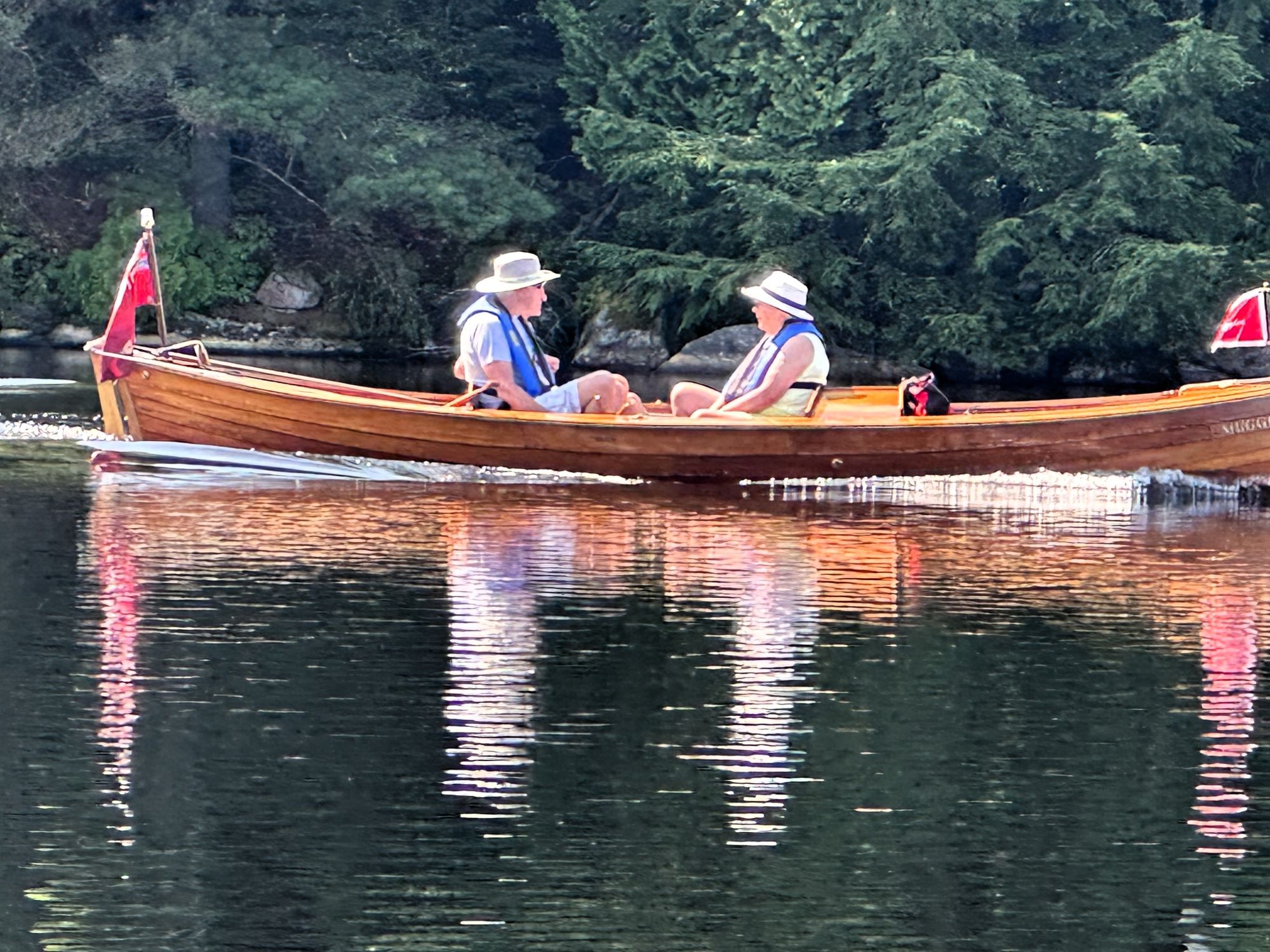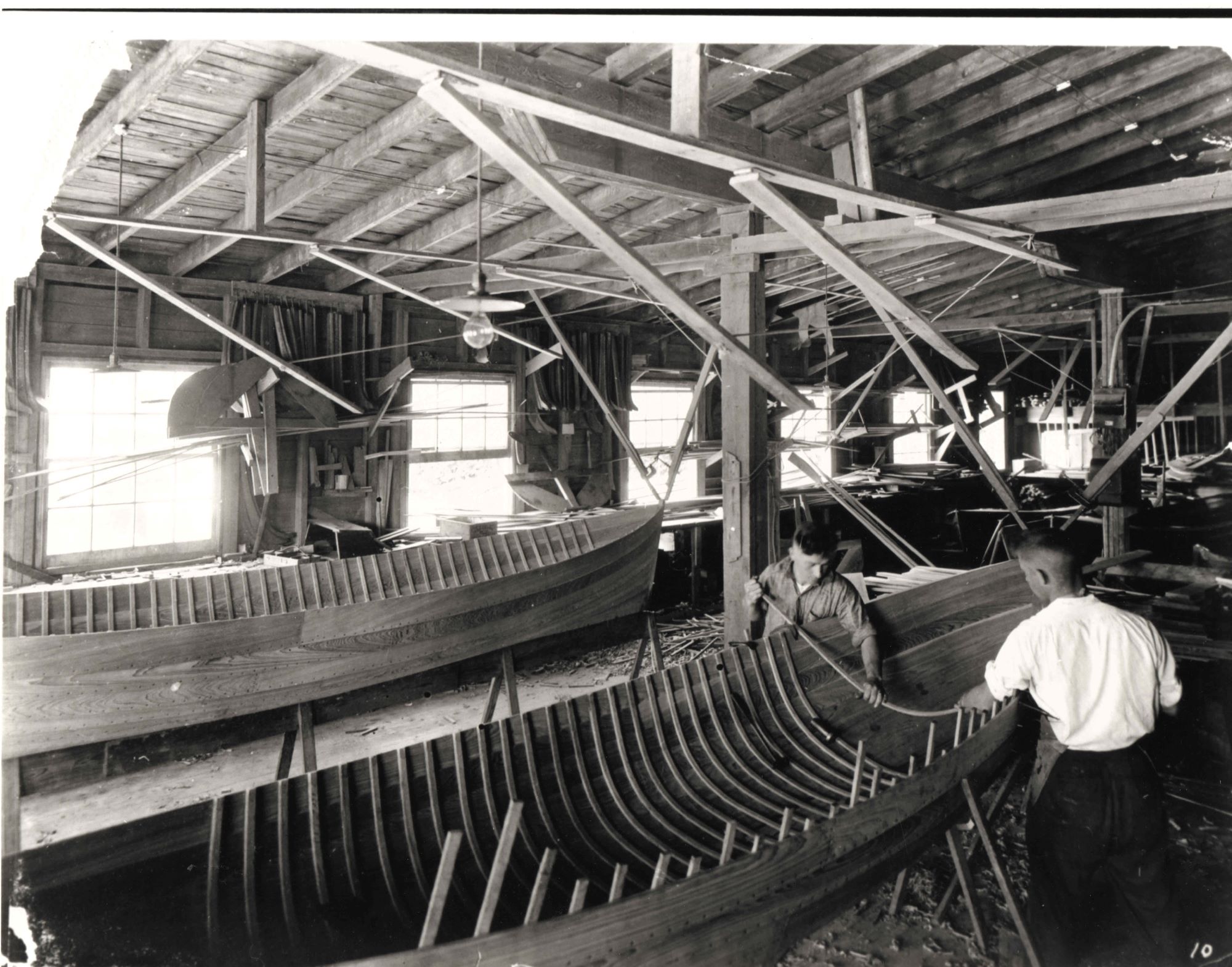The Dispro Story
The Greatest Little Motorboat Afloat

The Disappearing Propeller Motorboat is basically a double-ended lapstrake rowing skiff that was converted to a power boat by mounting a single-cylinder, low horsepower 2 cycle inboard gasoline motor in the centre. The motor was connected by way of a universal joint, to a hinged and elevating propeller shaft that also protected the rotating propeller from underwater impact damage using a curved skeg propeller guard.
The Disappearing Propeller “Device” was invented in Port Carling and is attributed (with some controversy) to skiff and launch builder W. J. “Billy” Johnston Jr. (1881-1968) a resident of Port Carling. Johnston, with financial and legal support, applied October 23, 1914 for a Patent that was granted on March 16, 1915.
The Dispro (an abbreviation) was quite different from other inboard launches of that time because of it’s patented “Device”. The propeller shaft, propeller and skeg could be easily raised by the operator into a cast iron or aluminum housing to be flush with the boat’s bottom for storage, docking or beaching. Additionally, if the hinged skeg was accidentally impacted on rocks, logs etc. while underway, it would automatically swing up into the housing and thus prevent any serious damage. This was an important safety and economic factor in the uncharted recreational boating waters of that time period.
This extremely quiet little motorboat, known later as “The Silent” Dispro, was an immediate success. This was largely due to its timely market introduction, relatively low cost and its special usage features. Considered by many as the Model T of the marine industry, it cost about the same as the Ford automobile of that time with models starting at $225.00 F.O.B. Port Carling. Perhaps for the first time since the introduction of gasoline powered boats, a more average income cottage owner or fisherman could afford the pleasure of buying and operating his or her own motorboat.
The original motor for the Dispro was the single cylinder 2 Horsepower, 2 Cycle copper jacketed “Waterman” engine from Detroit, weighing in at just 46 pounds. This gave way to the Canadian copied 2 ½ HP. “Kingfisher” and the 3 HP. “Silent Dispro” which was by far the most popular in initial production numbers. Later a few Quebec-built “Caron” motors and many “St. Lawrence” motors from Brockville were used by Lindsay and Greavette. A 4 HP. 2 Cylinder opposed twin 4 Cycle English Coventry Victor motor was used by Greavette on early 1950 and later production. Normal fuel consumption for the Dispro was 25 miles per gallon at a cruising speed of 6 or 8 miles per hour.
In the early 1920s the Dispro boat was produced in large numbers at the Port Carling factory, reportedly producing up to 300 to 400 units per year. A large export demand for the Dispro boat prompted the opening of a franchised American plant in Tonawanda N.Y. which only operated for 2 years. (1921-1922) A number of boats were reported to have been exported as far away as South America and China.
In 1923, things began to look bleak for the future of The Disappearing Propeller Boat Company for several reasons, some of which were: a sudden downturn of the economy following W.W I; overly optimistic sales forecasting which resulted in high factory inventory of unsold product; competition and many advances in new high speed, low weight outboard motors, and; serious partnership disputes regarding all of the above. The final blow was struck in July 1924 when the Bank of Nova Scotia foreclosed on outstanding debts, forcing the company into bankruptcy.
Following a period of litigation, the assets of the company and the Patent Rights were sold to Tom Hodson of Lindsay Ontario. Despite a valiant effort to revive the company in 1925 and 1926 by Hodson and the talented sales and plant manager William G. Ogilvie, they could not generate enough sales orders to keep the boat plant operating and it closed its doors for good in 1926.
A bitter Billy Johnston and several of his former senior foremen and managers moved to the upper side of the Port Carling locks and built a brand new boat plant, naming it the Port Carling Boatworks. Here they started building the now famous line of Seabird boats. But that, friend, is another story for another day.
When the Dispro factory closed in 1927, the assets and Patents were purchased by Toronto businessman Charles J. Barr, who was convinced there was still a market for the Dispro boat on a “build to order” concept, rather than mass production and resulting inventories. Barr made a contractual agreement with skilled boatbuilder Samuel Botting of the Lindsay Boat Company to make Dispros as required when orders were taken.
Fate stepped in again with The Great Stock Crash of 1929, with Charles Barr losing all of his many holdings in the devastating North American stock market failure. Sam Botting, with help from a struggling young Lindsay lawyer friend named Leslie Frost, was awarded the residuals of Barr’s boat company, including the Dispro Patents, by reason of default in contractual payment. Botting re-named it The Lindsay Disappearing Propeller Boat Company and produced a number of fine quality Dispro boats up to 1935. It is estimated that Lindsay Dispro production was approximately 150 boats in total.
The building of the Dispro boat returned to Muskoka when the Greavette Boat Company of Gravenhurst purchased the patterns and patents from Sam Botting in 1936. It seemed rather odd (and was reportedly very unpopular with many employees) that Thomas Greavette would undertake the building of slow old Dispros. After all, Greavette was well known for building its famous Streamliner models and internationally famous “Miss Canada” series of racing boats for Harold Wilson and his father Ernest Wilson of Ingersoll.

Tom Greavette, it seems, had always had a soft spot in his heart for Dispro, as several of his brothers had worked at the original Disappearing Propeller Boat Company plant in Port Carling. He planned to build the Dispro as a “Fill-in” project between major production of other popular boat models. Greavette builders made several improvements in machinery and hull design of the Dispro, producing approximately 400 units in the Bay Street, Gravenhurst plant between the years 1936 to 1958.
With only a few exceptions, Johnston and Lindsay Dispro boats were constructed with Cypress wood planking and White Oak ribs. Greavette Dispros were, again with only a few exceptions, planked with Western Red Cedar and steamed White Oak ribs. Greavette also introduced the smooth-running electric start English Coventry Victor motor circa 1950. This provided a much smoother and faster ride. Greavette also retrofitted many older model Dispros with the new Coventry Victor motors.
The Dispro was made in three basic models. The “Waterford” was 16’- 6” in length with a 49” beam. At times this was alternately known as the “Scout” model. The “John Bull” was 16’- 6” long but had a very wide beam of 59” resulting in larger carrying capacity. The “Uncle Sam” model at 18’ – 6” length and 56” beam was the largest and most popular model built. It should be noted here that Greavette Boat Company built only the larger 18’ – 6” version for all their Dispro production.
Advertised as “The Greatest Little Motor Boat Afloat,” just over three thousand Dispros were made over the years. Unfortunately, most have succumbed to time and rot. Although originally very well built, the majority were done in by pure neglect, improper care, uncovered outside storage and slapstick amateur repairs. Some are known by the author to have ended up as fuel for a family corn roast or made into cottage flower boxes. Some were even ceremoniously “sunk at sea” to dispose of the unsightly hulk.
The Dispro boat was produced for 44 years from 1914 to 1958, a number thought to be unmatched by any other single design among small motorboats. Certainly, the known production record speaks for itself and defies any suggestion that the Disappearing Propeller Boat was a mere “gimmick”. The self-preserving running gear and high fuel economy was certainly not a gimmick to the many owners who ran them over rocks and logs in Northern Lakes and rivers, some boats lasting for several generations of family.
Combined with the timeless beauty of its skiff design, the Dispros simple and safe motor and propulsion system has clearly earned it a high place of honour. Their nostalgic lines and legendary performance are remembered and held dear in the hearts and minds of many cottagers, boatmen and fishermen, as well as present day owners and enthusiasts.
By Joe Fossey
Founding President of The Dispro Owners Association



